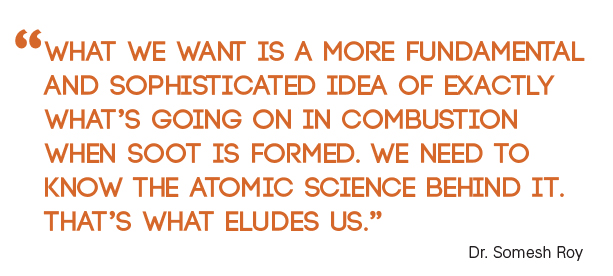Dr. Somesh Roy uses computer simulations and machine learning to examine how soot, a major environmental concern and contributor to climate change, spreads and persists.
By Chris Barncard

Humans have hundreds of thousands of years of experience with fire, but there is still plenty to learn about one of fire’s most influential byproducts: soot.
Soot is both a public health issue — linked to cancer and heart and lung diseases — and a pollutant that ranks with methane among the most significant contributors to climate change after carbon dioxide. Reducing soot production is important, but so too is mitigating its presence. And that depends on fundamentally understanding how soot forms, spreads and persists in the environment.
The basics of soot formation are as simple as they are familiar: Turn up a thermostat, preheat a gas stove, start a car, light a match and carbon atoms caught up in the resulting combustion clump together as soot. But soot particles come in a wide variety of sizes, shapes and internal structures, according to Dr. Somesh Roy, assistant professor of mechanical engineering.
“Just like snowflakes, there are no two soot particles that are perfectly alike,” he says. “We’re still trying to figure out how their structures are formed and changed.” Differences in surface area, volume and shape alter the way soot particles absorb heat energy from the sun, contributing to climate change, as well as how they affect human health.
With support from a five-year, $550,000 National Science Foundation CAREER Grant, Roy plans to unlock some of the secrets of soot.

“What we want is a more fundamental and sophisticated idea of exactly what’s going on in combustion when soot is formed,” he says. “We need to know the atomic science behind it. That’s what eludes us.”
With help from Raj, Marquette’s NSF-funded high-performance computing cluster, Roy will create computer simulations of combustion at the molecular level. He will also collaborate with Eirini Goudeli, lecturer of chemical engineering at the University of Melbourne, Australia, on these simulations.
“We will take the fuel and oxidizer and follow each atom individually and see how they’re evolving,” says Roy. “We will augment that data with high-resolution microscopic images of soot particles.”
No one has attempted this kind of simulation, leaving the details that shape the sooty snowflake a mystery. Are soot components packing together around a central structure? Or are some structures like graphene, an atom-thick sheet of carbon, rolling and curving into a soot sphere? Do the presence of specific atoms or contaminants — hydrogen, oxygen or sulfur — aid or hinder the development of soot particles?
Roy says when he and his team have many, many simulations of sooty snowflake evolution, they will use machine learning, an artificial intelligence technique, to predict how molecular interactions of soot influence the world at large. Roy’s lab will collaborate with Cristinel Ababei, associate professor of electrical and computer engineering at Marquette, on the machine learning process, building predictions that can describe soot formation in stoves, engines or even power plants.
“That knowledge can change how we design our combustion systems to control the amount or qualities of the soot they create,” Roy says. “And it can help guide policy to limit particular sources and mitigate the effects of soot.”
On the way to new, fundamental understandings of soot formation, Roy hopes to help the public better understand the role the pollutant plays in human health. The NSF CAREER Grant, an award for promising early career research, will also support opportunities for non-scientists to learn more about soot, including a partnership with the Haggerty Museum of Art to show how soot has affected paintings and photographs over decades and centuries. Roy also plans to partner with Milwaukee environmental education organizations to describe how different kinds of soot have accumulated around the city, especially in low-income neighborhoods, influencing city planning and illuminating issues of environmental justice.



